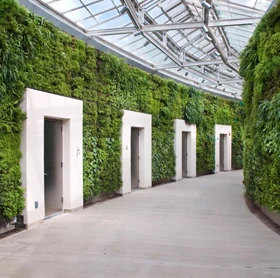|
 Interest surrounding green roofs and walls continues to grow, and one of the best places to see this trend in action is Longwood Gardens in Kennett Square, Pa. Interest surrounding green roofs and walls continues to grow, and one of the best places to see this trend in action is Longwood Gardens in Kennett Square, Pa.
Home of the largest green wall in North America, Longwood is an excellent source of inspiration for garden retailers looking to delve into the world of vertical and rooftop gardening. Longwood’s new vertical garden features a panel wall system to support more than 47,000 plants and encompasses a surface area of 4,072 square-feet—making it more than 70 percent larger than the previously largest indoor green wall.
The majority of the 25 plant species featured in Longwood’s living wall are fern varieties, including the evergreen holly fern, the versatile, showy rabbit’s foot fern, the button fern, the asparagus fern, and the delicate and lacy maidenhair fern, among others.
Why did Longwood decide to build a green wall? “The catalyst for the green wall was quite simple: Longwood needed more restrooms for our guests,” said Patricia Evans, spokeswoman for Longwood Gardens, “Longwood has a long tradition of leadership in environmental stewardship, and we decided that the East Conservatory Plaza was yet another opportunity to use the innovative design and sound environmental practices to create a remarkable addition to the gardens.”
Clearly, a run-of-the mill restroom facility wouldn’t fit the bill. Kim Wilkie, a United Kingdom-based landscape designer, came up with the East Conservatory Plaza’s plan, which includes the green wall—and more restroom space. Wilkie worked with building architect Michaelis Boyd and local project landscape architect Wells Appel, located in Philadelphia.
“The project took about three years from original concept to completion. Construction began in fall 2009 and was completed in October 2010,” said Evans.
Plans take shape
Denise Eichmann, project manager for Ambius Project Development North America in Buffalo Grove, Ill., was hired to install the green wall at Longwood. According to Eichmann, the green wall is a panelized modular system from GSky Plant Systems in Vancouver, British Columbia.
“We begin the process with plant selection and plant drawings,” said Eichmann. “The plants are purchased as small liners and pre-grown into the panels at a certified nursery for 16 weeks prior to shipping to the project site. The plants were grown under 73-percent shade to prepare them for interior light conditions.”
Eichman worked with Wells Appel, Ambius, and key people from Longwood’s horticulture team to select plants for the vertical wall.
“The process began with a list of potential plant species from Wells Appel. I compared it to a draft of players for a professional team. We had numerous rounds of conference calls where we each compared notes on particular plant species under consideration – the growth habit, the lighting requirements, the susceptibility to pests.
“A light study was performed to detail available light at all points on the walls at different times of day and different seasons. All of this information was pooled together in our discussions. We analyzed each species until we cohesively agreed upon 26 selections we planted to meet the design pattern created by Wells Appel,” explained Eichmann.
Nuts and bolts
Eichmann has this advice for garden centers considering green wall offerings: “Invest time into planning, research and trial on a small scale. There is nothing to replace experience.”
Evans said Longwood’s guests have been inspired by the green wall. “We actively educate our guests about the energy-efficient design of the restrooms, and the environmental benefits of the green wall—guests are amazed that the wall produces the equivalent oxygen of 90 14-foot trees!
“But I think I am most pleased that the East Conservatory Plaza captures the very essence of Longwood Gardens: It is deeply rooted in tradition, while also embracing innovative landscape design, and is engaging our guests in new and exciting ways.”

Modular systems, like WoollyPockets, allow gardeners to create vertical gardens indoors and out. Photo: Joshua White |
Several companies are now offering unique ways for garden centers to sell the green roof/wall concept.
Jim Rizzo, of Bright Green (www.brightgreenusa.com), describes his company’s system:
“Our planter has 10 vertical planting cells, which allow the consumer or designer endless possibilities for design,” he said. “Our product works great with ground covers, herbs, annuals and perennials. It’s easy to water by using our irrigator for one or two planters or by simply hooking it to an irrigation kit.”
Another excellent option comes from Woolly Pocket (www.woollypocket.com). This system is made from 100-percent recycled plastic water bottles. The pockets are breathable and modular.
“The breathable ‘felt’ keeps plants happy, and the material is flexible so that the pockets can be easily attached to odd places, like corners,” said Justina Blakeney of Woolly Pocket.
The company has also developed resources that garden centers can adopt to teach employees and customers how to use the pockets…
- Painting with Plants—where the vertical wall is used as a palette, and the paints are the plants.
- Videos that explain the process of installing, planting, and watering the pockets.
- Garden-Inspired Journeys, which encourage garden centers to use fences, empty walls, and overhead areas to place Woolly Pockets as billboards, advertising vertical gardens.
|
|
Wendy Komancheck is a freelance writer in Ephrata, Pa.
|



 Interest surrounding green roofs and walls continues to grow, and one of the best places to see this trend in action is Longwood Gardens in Kennett Square, Pa.
Interest surrounding green roofs and walls continues to grow, and one of the best places to see this trend in action is Longwood Gardens in Kennett Square, Pa.






